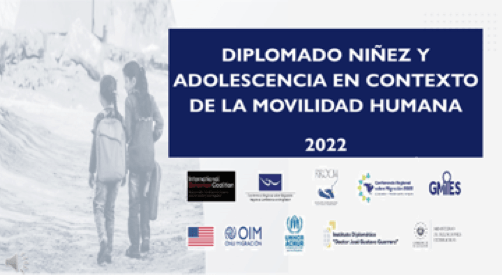As the movement of people from one territory to another becomes increasingly more frequent, the ways in which this happens has transformed. In the recent past, groups were generally small and were transported as inconspicuously as possible. Most of the group would comprise of men, and economic-labor motivations lay behind most migration.
Current migration dynamics are more diverse: expulsion factors have increased and intensified; groups gather in caravans and travel on main highways to border points; traditionally male migration has gradually decreased with an increase of migrant women; and there has been an alarming increase in the number of children crossing borders, either accompanied, unaccompanied, or separated from their parents or legal guardians.
Such a context demands that the State, and the various actors that comprise it, develop mechanisms for the specific attention and protection of all those immersed in voluntary or forced processes of migration. Special emphasis needs to be placed on the most vulnerable, such as children, founded on the “best interest” principles of this population.
According to the Committee for the Rights of Children,[1] the best interest of the child is a right, a principle, and rule of procedure. It demands the adoption of a rights-based approach, in which all parties seek to guarantee the physical, psychological, moral, and spiritual integrity of children and to promote their human dignity, encompassing in the term “children,” both an individual and general or group character. “Best interest” of the child is thus understood as both a collective and an individual right.
The Committee has also referred to how the best interest of the child should be applied, arguing that pre-evaluations of legislative provisions, public policies, and their implementation, should be conducted in order to assess their potential effects on the rights of children, together with a post-evaluation of the consequences of their application.[2]
Considering the context of migration, as well as international doctrine and regulations, the need to support and strengthen the capacity of the various regional institutions involved in attention and protection of migrant children has been identified. This would enable the implementation of effective approaches that respond to both the humanitarian needs of this population as well as to intentional design of life projects, all founded on the best interest of the child.
In order to support the development and strengthening of the technical abilities of personnel from the above mentioned institutions, and within the framework of the 26th Regional Conference on Migration (RCM), a Diploma on Migrant Children was offered. The Diploma was designed to strengthen the technical capacity of those working in institutions that participate in processes of migrant children, in order to protect this population.

The Diploma design was based on a proposal by Grupo de Monitoreo Independiente de El Salvador (GMIES), and was reinforced by a participative and consultative process with the International Organisation for Migration, International Detention Coalition (IDC), the International Labor Organisation, and the United Nations High Commissioner for Refugees, as well as by the representation of the Pro-Tempore Presidency (PPT) and the Regional Conference on Migration. Together, this allowed for a holistic, specialised, and consensual vision of the different bodies that, from their own particular position, address one or more aspects of human migration.
The Diploma was delivered to 41 participants from public institutions and non-governmental organisations from 10 countries in the Mesoamerican region. On completion of their training, each participant received a certificate from the “Doctor José Gustavo Guerrero” Specialised Institute. This Institute provided a perfect space on their platform for the transmission and reinforcement of knowledge, including simultaneous classes for consultation and feedback; pre-recorded classes that could be watched at participants’ convenience, and forums to respond to any questions.
The Diploma was divided into three modules, progressing from a general to a specific perspective, with information on the provision of immediate attention, as well as on accompaniment and orientation for life projects that ensure a decent standard of living. A brief summary of the contents of each module is presented below:
| MODULE I. UNDERSTANDING THE REALITY OF MIGRANT CHILDREN | Exploration of the regional context and reality of migrant children, with particular emphasis on the structural causes of countries of origin that give rise to migration, as well as the characteristics of migrant children. Analysis of situations of vulnerability. Examination of risk situations, such as human trafficking, trafficking of migrants, discrimination based on indigenous identity, belonging to the LGBTTTIQA+ community, migrant detention, gender based sexual violence, among others. Provision of tools to identify vulnerabilities, with particular emphasis on interview techniques. |
| MODULE II. MIGRANT CHILD PROTECTION
| Examination of the international and regional legal framework as well as of standards for the protection of the rights of migrant children; minimum regulations for protection, asylum and statelessness, child labor. Strengthening the technical capacity of comprehensive mechanisms for the assistance and protection of migrant children: application of best interest, humanitarian action, mental health, and alternative care for unaccompanied and separated children. |
| MODULE III. IDEAL ECOSYSTEMS FOR THE DEVELOPMENT OF MIGRANT CHILDREN’S LIFE PROJECTS
| Presentation of mechanisms for reintegration in countries of origin for returned migrant children, as well as mechanisms for integration in destination countries, considering the various migration dynamics and their possible effects on migrant children Exchange of good practices for the protection and development of migrant children, and examination of state and civil society responses to the current reality. |
The Diploma ended on 13 October 2022.
[1] United Nations Organization, Committee for the Rights of Children, General observation Nº 14 (2013) on the rights of the child to have their best interests taken as a primary consideration (article 3, paragraph 1). Approved by the Committee in its 62nd session, held from January 14 to February 1, 2013.
[2] Op. Cit.
Written by Pamela Anthuanee Franco, Grupo de Monitoreo Independiente de El Salvador (GMIES)